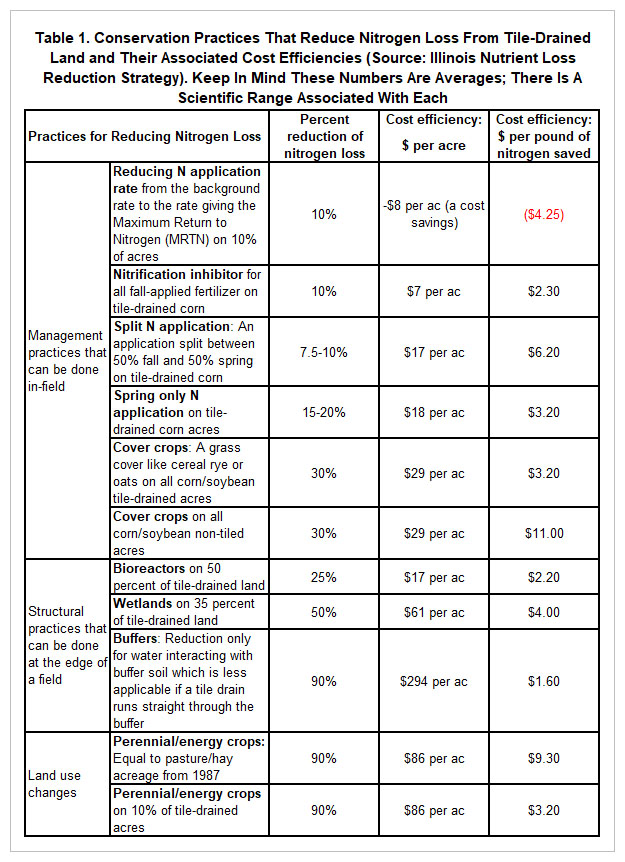Nitrogen Loss Reduction Practices: What Do They Cost?
Subsurface tile drainage networks significantly underpin agriculture across the US Midwest with Illinois alone possessing nearly 10 million tiled acres. However, nitrogen that leaves Midwestern fields in tile drainage water can impair local water bodies used as drinking water sources and is known to contribute to the hypoxic zone (or, “dead zone”) that forms seasonally in the Gulf of Mexico. Growing global food and biofuel demand combined with increasing societal pressure for clean water mean the agricultural community must be offered workable solutions to meet productivity goals in ways that don’t result in nutrient-impaired waters.
A variety of agricultural conservation practices are available to reduce the amount of nitrogen leaving fields and travelling downstream. The practices are generally grouped into three categories: management practices that can be done in-field, structural practices that can be built at the edge of a field, and land use changes (Table 1). While each individual practice is valuable, the nitrogen removal effectiveness will be site specific and the acceptability of each individual approach will differ between producers. No given conservation practice will be capable of addressing drainage water quality concerns in entirety; as such, a suite of approaches used across the landscape will be required. As substantial investments in drainage systems continue to be made across the Midwest, there is an increasing need to provide relevant decision making information to agricultural producers and landowners so they can assess the best way to better incorporate conservation practices into the local landscape.
Each practice’s effectiveness for reducing nutrient loss in terms of a “percent effectiveness” can be compared. For nitrogen loss through tile drains, research shows that practices addressing the drainage system itself tend to be more focused and have relatively high practice efficiencies. For example, woodchip bioreactors and wetlands are rated at 25% and 50%, respectively, in the Illinois Nutrient Loss Reduction Strategy, meaning they keep one quarter and one half, respectively, of the nitrogen that would otherwise move downstream from doing so. The most effective practices for reducing nitrogen loss through tile drains tend to be land conversion practices which require switching production to perennials like pasture or bioenergy crops (90% N loss reduction). While Table 1 presents average values, nitrogen loss reduction effectiveness of any practice can vary by soil type, topography, landscape position, and weather.
Another way to compare these practices is cost efficiency, both in terms of dollars per acre and dollars per pound of nitrogen that is being kept from moving downstream (Table 1). While the land use change practices are the most effective in terms of percent nitrogen loss reduced (90%), they do no tend to be some of the most cost effective practices. However, beyond the cost efficiencies listed in Table 1, it’s very important to note that some practices provide additional benefits beyond reducing nitrogen loss in tile drainage. For example, there is evidence that long-term use of certain cover crops can improve soil health, and constructed wetlands are known to provide pollinator habitat and can be of interest to hunters for providing wildlife habitat.

To compare these practices based on cost, a few additional considerations include:
- When do the major costs of the practice occur? Constructed edge-of-field practices like constructed wetlands or bioreactors have high up-front costs, while other practices like cover crops are implemented annually, and thus have repeatable costs occurring every year.
- What is the lifetime of the practice? Continuing with the above example, a constructed wetland can have a design life of greater than 100 years, but it may not be reasonable to assume a cover crop will be done in a given field consecutively for 100 years.
- Are there other benefits of the practice, beyond water quality improvement, that are important? The practice of cover crops, for example, is typically not done solely to reduce nitrogen loss in drainage water.
- Are there local or seasonal price differences for costs of these practices?
- Are government incentives or cost-share programs available to assist with the cost? There may also be local funds available in certain watersheds through conservation groups or watershed planning processes.
In summary, all the recommended nutrient loss reduction practices are unique in how they work, how well they work to reduce nutrient loss, ease of implementation, and cost. While no single practice will be suitable for every acre across the US Midwest, every single acre needs at least one new conservation practice.
For more information on these practices, please contact the University of Illinois Extension or the USDA NRCS. Online factsheet resources are also available on this topic at:
http://go.aces.illinois.edu/TenWays
http://go.illinois.edu/UseScience
Disclaimer: We request all readers, electronic media and others follow our citation guidelines when re-posting articles from farmdoc daily. Guidelines are available here. The farmdoc daily website falls under University of Illinois copyright and intellectual property rights. For a detailed statement, please see the University of Illinois Copyright Information and Policies here.







